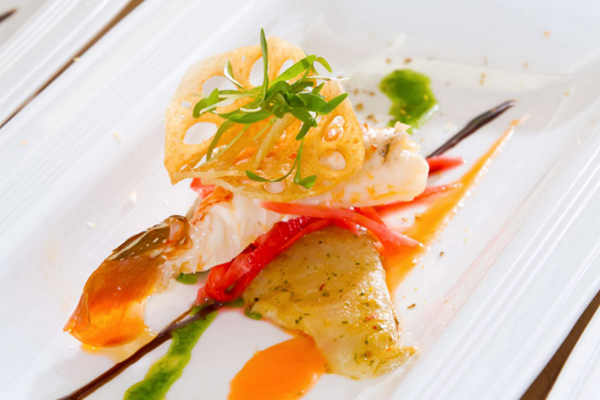Tru Bahamian Must Eat: Lionfish

What lionfish aren’t as well known for, however, is their delicious white meat. That’s right. Contrary to what their elaborate appearance might insinuate (with all those spines and sharp looking wings), lionfish is in fact edible since their venom is confined to their spines – not their flesh. These intrusive newcomers are safe to eat and boy are they tasty! In fact, consuming lionfish as a food source is also a moral imperative. Marine scientists recommend catching and eating lionfish as one of the most effective ways in curbing their population growth and controlling their expansion. With their delicate, buttery flavour, these fish are quickly becoming an exquisite delicacy in these islands. The fact that the act of eating them is a boom to both your tastebuds and the environment is doubly satisfying.
Lionfish – tall spines and all- is definitely a Tru Bahamian Must Eat!
How Did Lionfish Get Here?

Credit: EarthIsland.org
Lionfish are not a native species to The Bahamas or anywhere in the Atlantic Ocean for that matter. Red lionfish (the most common species found in these waters) are native to the subtropical and tropical region of Indian and Pacific Oceans. It is thought that these exotic fish were likely released into the Atlantic Ocean off of the coast of southeastern USA in the mid 1980’s and have been reproducing at a speedy clip ever since. To date, they’ve been discovered as far east as Barbados and as far south as Venezuela.
What Do They Taste Like?

Credit: Florida Wildlife
Lionfish is a dense, sweet, mild fish with white meat that is very soft and flaky. It’s firm in texture somewhere in between a snapper and grouper and has a flavour profile similar to mahi-mahi with a touch of butter. We find it helpful to heed the suggestion made by Scott Harrell, co-founder of the World Hunters Lionfish Association, who described lionfish as “a quality canvas that readily accepts paint – the brighter the canvas, the more vivid the colours present themselves.” The culinary possibilities are endless!
Let’s Eat!

Credit: Luciano’s of Port Lucaya
Are you ready to add lionfish to your regular seafood menu rotation? Luckily for all of us, lionfish is appearing more and more frequently on the the menus of some Bahamian restaurants throughout the islands and even at local farmers’ markets throughout the year. There are a number of pioneering restaurants on Nassau that are currently serving this newly-minted delicacy including our good friends at Graycliff Restaurant in downtown Nassau, Billfish Grill at the Eastern end of the island, and Mahogany House located in Lyford Cay. On most Saturday mornings from 9am to 1pm, you can treat yourself to freshly prepared lionfish tacos from Seasonal Sunshine Bahamas Farms at the Doongalik Farmers’ Market. In Freeport, you’ll find award-winning Chef Tim Tibbits serving up lionfish at his acclaimed restaurant Flying Fish, and you’ll also be able to try it at Luciano’s of Port Lucaya. In Bimini, you can find it at Bimini Big Game Club.
You can also check out who’s serving around the world with this extensive international list. As far north as New York City, you can even come across Bahamian-inspired lionfish plated at Norman’s Cay Restuarant by Chef Chadwick. We hear that he loves to grill or fry it with tomatillo, chickpeas, salsa, and fennel, or serve it raw as a lionfish crudo with jalapeño vinaigrette, mango, pickled red onion, and mint (OMG!!!).
From lionfish sashimi, ceviche, to delectable beer-battered fillets with dill tartar sauce, or even a warm lionfish stew, there’s a multitude of ways to prepare and enjoy this seafood variety. If you’re super eager (and a little brave), you can try these recipes of lion fish deliciousness at home using the recently released Lionfish Cookbook called “Eat ‘Em to Beat ‘Em” by REEF (Reef Environmental Education Foundation). And, aforementioned Grand Bahamian Chef, Tim Tibbitts (recently named one of the Top 25 Chefs in the Caribbean), has even produced a series of gourmet lionfish how-to videos to guide your intrepid endeavours with this fish in the kitchen.
Are You The Catch & Eat Type?

Credit: Doongalik Farmers’ Market
With fishing comes fishing tournaments. And, over the past few years, a number of lionfish “derbies” have launched throughout the islands. Often organised as special day-long or weekend-long tournaments with generous cash prizes for winners- these events primarily for the purpose of collecting, removing and, most importantly, eating as many lionfish as possible. They have proven to be incredibly popular among local fisherman, boat owners, and their families and friends. Not only can you enjoy lionfish tastings at these events (in every form imaginable), but also relish in their the accompanying festivities which often include live music and chef-demos. Best of all, these derby events also help to draw media attention to the Atlantic lionfish invasion and help to grow the commercial lionfish market.
The latest lionfish derby, includes the 8th Annual Green Turtle Cay Lionfish Derby in Green Turtle Cay, Abaco. Scheduled for June 24-25, 2016.
